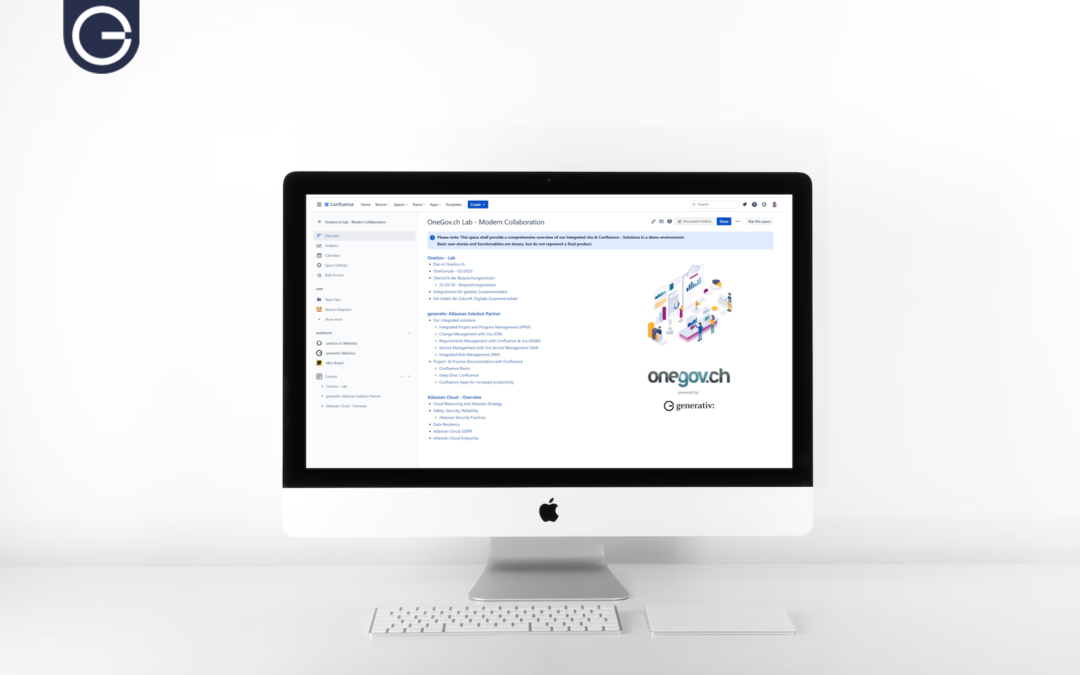In an increasingly digitalized world, public administration is also required to adapt to the changes. New technologies and innovative approaches are revolutionizing the way we work and enabling new services. In this dynamic environment, public administration is faced with the central task of adapting to the unstoppable changes and using the opportunities offered by digitalization to make its services more efficient and user-friendly.
“A proper digital transformation turns a caterpillar into a butterfly. A badly done one just gives you a really fast caterpillar.”
– George Westermann
In this article, we take a look at the challenges and opportunities that arise for public administration in the course of digital transformation.
Challenges of the digital transformation
In an era characterized by rapid technological advances, digital transformation is taking place not only in the offices of the corporate world, but also in public administration. The digital revolution has impacted our society in many ways – from the way we communicate to our expectations of how we interact with government institutions. In this context, public administration is faced with the challenging task of adapting to the unstoppable changes in order to make its services more effective and user-friendly and to take advantage of the opportunities offered by digitalization.
Traditionally seen as the epitome of bureaucracy and complex administrative processes, public administration is reinventing itself and opening up a world of digital possibilities. The digital transformation includes the shift from paper-based processes to electronic workflows and the integration of artificial intelligence, data analysis and automated decision-making. This transformation has the potential to fundamentally change the relationship between citizens and public administration – towards a collaborative partnership based on efficiency, transparency and improved service.
There are three main challenges to overcome:
- Cultural change: One of the biggest challenges lies in changing the work culture and the mindset of employees. Traditional processes and hierarchies need to be reconsidered in favor of more agile and collaborative approaches.
- Data security and data protection: The increasing use of digital platforms and databases also increases the risk of data breaches. The public administration must implement strict security measures to protect sensitive data.
- Bureaucratic hurdles: The introduction of new technologies often requires changes in bureaucratic processes and regulations. If no active efforts are made to overcome these obstacles, this can lead to resistance and delays.
The digital transformation brings with it significant challenges that need to be tackled carefully. A fundamental cultural change is needed to break down rigid hierarchies and encourage innovation. The security of sensitive citizen data is crucial, as the increasing use of technology also entails data protection risks. Bureaucratic structures need to be adapted to make room for digital innovation. The digital divide must be overcome so that everyone can benefit from the advantages. Finally, the acceptance of new technologies requires an open dialog to overcome resistance and fears.
… and opportunities of the digital transformation
However, the opportunities of digital transformation in public administration go far beyond increasing efficiency. They offer the opportunity to revolutionize the interaction between citizens and administration and to establish future-oriented, data-driven governance. If public administration recognizes and makes use of these opportunities, it can play a pioneering role in shaping a modern and citizen-oriented administration.
- Increased efficiency: Work processes can be streamlined and accelerated through the use of digital tools. This leads to a more efficient use of resources and allows employees to concentrate on more demanding tasks.
- Better citizen services: Digital platforms enable public administration to make citizen services more user-friendly and accessible. Online services for administrative matters can reduce waiting times and facilitate access to information.
- Data-based decision-making: Digital transformation enables the collection and analysis of data in real time. This enables well-founded decisions to be made in order to continuously improve processes and better understand needs.
- Participation and transparency: The digital transformation enables closer cooperation between the administration and citizens. Citizen participation platforms and social media offer opportunities for open dialog and feedback. This promotes citizens’ trust in the administration and helps to ensure that political decisions are based on people’s needs and opinions.
- Sustainability and environmental protection: Digitalization allows paper-intensive processes to be minimized, reducing paper consumption and environmental impact. In addition, monitoring energy consumption and resource use enables more targeted implementation of sustainability measures.
In summary, this means The digital transformation opens up a wealth of opportunities for public administration. The introduction of automation and workflow management systems can increase efficiency, which in turn creates space for innovation and creative tasks. Online platforms and mobile apps make it possible for citizens to carry out administrative tasks from the comfort of their own home. This shortens waiting times and improves interaction with the authorities. Data analysis can be used to make informed decisions and identify trends in areas such as policymaking and resource allocation. Cooperation between administration and citizens is strengthened by digital platforms, which leads to greater transparency and participation. Digitalization also contributes to sustainability, as paper-intensive processes can be reduced and the use of resources can be monitored. Overall, these developments open up new avenues for a more modern and citizen-oriented administration.
Our experience
A holistic approach is important when it comes to digital transformation. Organizations should analyze their processes and services to determine which tasks can be digitized and select suitable technologies and tools. It is also important to consider the impact on employees and ensure that they are adequately trained and supported. In today’s era of digital transformation, innovative technologies are crucial to optimize workflows and information management in public administration. Two powerful tools are Jira and Confluence, which can offer significant benefits not only in the private sector but also in public administration.
Jira as a workflow management tool: Jira was originally designed as a software development tool, but has since found its way into a variety of industries, including public administration. It provides a robust platform for managing tasks, projects and workflows. In administration, Jira enables the creation of customized workflows that reflect the specific processes and approvals within the organization. Possible areas of application include the processing of applications and complaints as well as the coordination of initiatives at cantonal or national level

A major advantage of Jira is its flexibility. The platform can be customized to your own requirements so that both internal and external interactions can be managed seamlessly. The ability to track the progress of tasks, meet deadlines and identify bottlenecks at an early stage can significantly increase administrative efficiency. In addition, data can be collected on the use of resources, enabling informed decisions on resource allocations.
Confluence as a knowledge database: The challenge of knowledge management in public administration is as real as it is important. This is where Confluence comes into play: a platform that acts as a digital knowledge database. Confluence makes it possible to store and organize information, documents, best practices and guidelines in one central location. This facilitates access to relevant information and promotes collaboration and knowledge sharing between different departments and employees.

In administration, Confluence can be used to document policies and procedures, archive historical data and reports and provide training materials. This is particularly important when changing work processes or introducing new employees. The platform also provides tools for versioning and sharing documents so that everyone involved always has access to the most up-to-date and accurate information.
Conclusion: Overall, Jira and Confluence offer an integrated solution that can help public administrations meet the challenges of digital transformation. By providing efficient workflow management and a robust knowledge base, these tools enable the administration to become more transparent, agile and effective, while improving the quality of service to citizens.
Concrete proposals
Every administration and every organization, as well as their respective requirements, are unique. Therefore, it is crucial to consider your specific needs and goals in order to achieve the best possible results in your digital transformation. However, the following general recommendations can serve as valuable guidelines to help you shape the path to successful digital administration:
- Establish a tailored digitalization strategy: The public administration should develop a clearly defined digitalization strategy that is tailored to its individual goals. This strategy should include clear milestones, objectives and available resources to ensure coordinated and focused implementation.
- Investment in training and further education: Employees are the backbone of any administration. It is therefore essential to invest in training and further education opportunities to familiarize them with new technologies and working methods. Training can reduce potential fears of change and promote acceptance of new processes.
- Collaboration with the private sector: Collaboration with the private sector can be a valuable resource. Best practices, innovative technologies and proven solutions can be adopted. Partnerships with private companies can promote knowledge sharing and lead to the development of ground-breaking solutions that have the potential to accelerate the progress of the administration.
A committed and strategic approach is required to successfully overcome these challenges. This is the only way for the administration to take full advantage of the opportunities and benefits of digital transformation. By taking these recommendations into account and adapting them to its individual circumstances, public administration can evolve into a more modern, agile and efficient institution. This would put it in a better position to meet the changing demands of society.
Further information can be obtained directly from us at info@generativ.ch or at: http://www.generativ.ch.
generativ GmbH was founded in 2018 as a specialized consulting company and software house in Zurich. Our focus is on digital business processes as well as solutions and methods relating to the Atlassian product range. In addition, we support you in digitization with open source solutions such as BlueSpice and Easy Redmine. We offer process and methodological expertise as well as solution architecture from a single source and support organizations in classic project and process management, the introduction of agile principles and digital transformation. We are attentive listeners, rational analysts, forward-looking consultants and experienced coaches. Together with our clients, we envision the working environments of tomorrow and thus enable lived processes as well as effective and efficient collaboration in and around organizations. More at: www.generativ.ch.



